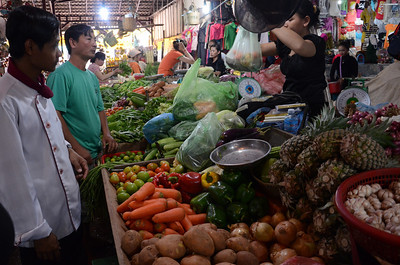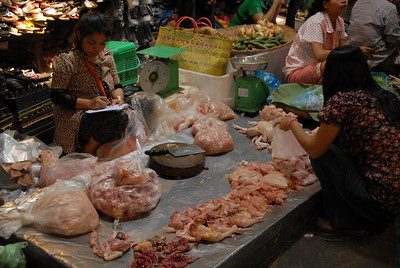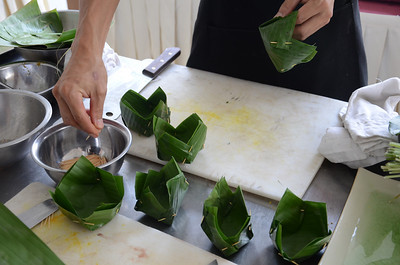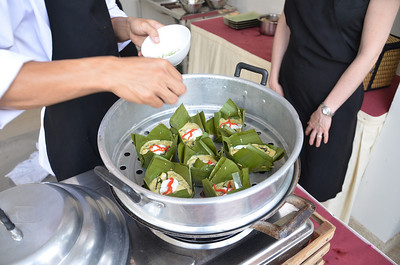
Ask that question 30 years ago and the answer would be far different than it is today. Ravaged by the Vietnam War and the reign of the Khmer Rouge, folks there were focused on basic survival, not on crafting their country’s cuisine. Yet, in spite of years of deprivation and starvation, Cambodians have persevered to create some of the most flavorful and freshest foods around. Last Friday I learned this firsthand by spending the day with a Khmer chef from Siem Reap, Cambodia’s Tara Angkor Hotel.

Since Cambodian cooking focuses on fresh, local ingredients, we took a tuk tuk to the market to pick up the provisions for our meal. Lemongrass, galangal root, kaffir lime leaves, turmeric, onions, string beans and sweet potatoes all made their way into our basket. Along with garlic the first four ingredients would appear in both the curry chicken and amok trey, or freshwater fish amok, that we’d make. Pounded together into a paste, this aromatic mixture is known as kroeung. A distinctly Cambodian or Khmer flavoring, it’s used in soups, stir fries, curries and the aforementioned fish amok.

Vegetables acquired, we moved on to fish and poultry. In keeping with the emphasis on fresh and local the chickens and fish came to the market alive and were butchered to order. The subsequent dishes created from these truly free-range chickens and fish were far richer, tastier — and authentic — than anything that I’d ever cooked with the factory-farmed, plastic wrapped-products from my local grocery store. Startling to see? A bit. Better to eat? Definitely.

Shopping finished, we headed into the kitchen and started cooking. After pulverizing our kroeung ingredients with a mortar and pestle, we assembled and cooked the curry chicken. As that simmered, we pinned together the banana leaf baskets that would hold the fish amok in a steamer. The “amok” in fish amok refers to the steaming of fish, chicken, tofu, etc. in banana leaves. It’s a traditional Cambodian cooking technique that results in a highly succulent, flavorful dish. If, like me, you’re a disaster at basket making, you can always steam the fish in ramekins. It’s not the customary method but it’s also potentially not as messy. Doubt the messiness? Just note the sagging, about-to-spill-over basket in the photo below.

Once the fish had been steamed, it was dressed with slices of red pepper and a drizzle of coconut milk. From here we could have just eaten the fish amok from its individual baskets. Instead we spooned it into coconut shells and served it in that fanciful manner. Moist, flavorful, fresh and fun, fish amok provided the ideal introduction to Cambodian cuisine.
FISH AMOK
Adapted from Chef Im at the Tara Angkor Hotel in Siem Reap, Cambodia
Serves 2 to 4
for the kroeung:
2 cloves garlic, peeled and chopped
1 tablespoon lemongrass, chopped
1 tablespoon galangal root, peeled and chopped
1 teaspoon fresh turmeric, peeled and chopped
1 piece ginger, peeled and chopped
1 teaspoon salt
for the fish:
2 tablespoons kroeung
3/4 pound fillet of cod or other firm, white-fleshed fish, thinly sliced
3/4 cup coconut milk plus extra for garnish
1 morinda/noni leaf, chopped
2 tablespoons fish sauce
2 teaspoons sugar
2 eggs, whisked
1/2 teaspoon salt
1/3 teaspoon black pepper
1/4 cup thinly sliced red bell pepper
steamed rice or soba noodles, for serving
Using a blender or mortar and pestle, pulverize the ingredients for the kroeung. Spoon 2 tablespoons of the kroeung into a large bowl. Add the fish, 3/4 cup coconut milk, morinda leaf, fish sauce, sugar, eggs, salt and pepper to the bowl and mix the ingredients together until well combined. Spoon the mixture into small, heat-proof bowls or ramekins, filling each about two-thirds full. Place the bowls or ramekins into the basket of a steamer, put the lid on and allow the fish to steam for roughly 15 minutes. When finished, the fish will be firm and cooked through.
Carefully remove the hot ramekins from the steamer. Garnish the top of each with slices of red pepper and a drizzle of coconut milk. Serve immediately with a side of rice or soba noodles.
Note: You can find galangal root, fresh turmeric and morinda/noni leaves at Asian supermarkets.